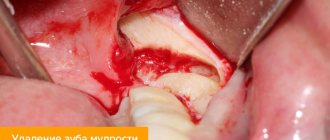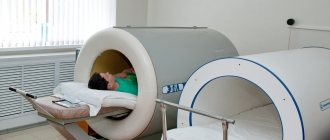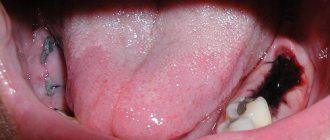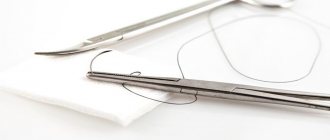From this article you will learn:
- Wisdom tooth removed - how long will it hurt?
- what are the complications?
- How long does it take for gums to heal after wisdom tooth removal?
The article was written by a dental surgeon with more than 19 years of experience.
According to statistics, after the removal of a wisdom tooth, inflammation of the socket of the extracted tooth occurs in 25-30% of cases. For example, after the removal of any other groups of teeth, inflammation occurs only in 3-5% of cases. This is due: firstly, to the higher complexity of removing wisdom teeth, and secondly, to the fact that they are surrounded by a large amount of soft tissue.
The last circumstance is very important, because the presence of moving soft tissues in the area of the extracted tooth socket often leads to the loss of the clot - its loss or even destruction. If the socket of the extracted tooth is not closed by a blood clot, inflammation will inevitably develop in it.
Gums after wisdom tooth removal (normal) –
When wisdom teeth are removed, stitches are almost always required. This is necessary because these teeth are located deep in the soft tissues and in this place the mucous membrane is very mobile. The absence of sutures in this situation can lead to prolapse of the clot and inflammation. But if the patient has a long jaw and there is enough space for the wisdom tooth, the socket will look traditional (Fig. 3).
To learn how the sockets of extracted teeth should normally heal, and how to speed up this process, read the article: “How long should gums take to heal?”
Why complications often occur after wisdom tooth removal -
It must be said that the severity of negative symptoms after wisdom tooth removal directly depends on the degree of traumatic removal. In turn, the incidence of trauma depends not only on the simple or complex position of the tooth in the jaw, but, first of all, on the qualifications of the dental surgeon.
For example, surgeons often spend 1-2 hours trying to remove a patient’s wisdom tooth with just forceps and an elevator - instead of immediately making an incision in the gum, drilling out some bone around the tooth and/or sawing the tooth crown into several parts (after that, removing each root by separately), and spending only 15-20 minutes on it.
Another main cause of complications after complex wisdom tooth removal is the use of a drill by the surgeon, the surgical tip of which is not water-cooled. As a result, a thermal burn of the bone occurs, followed by severe pain and the development of suppuration in the socket of the extracted tooth.
Important: thus, the main causes of inflammation and other complications are the mistakes and negligence of the dental surgeon during the removal process.
However, a lot also depends on the doctor’s prescriptions. Correct prescriptions dramatically reduce the risk of developing inflammation of the socket.
How to make regeneration faster
To make the recovery period shorter, you should treat the hole as carefully as possible. Several central means help speed up regeneration:
- Brush your teeth correctly. It is important that the oral cavity is cleaned properly and that pathogenic bacteria that can cause inflammation and other problems do not multiply in it.
- Use antiseptics. They need to be rinsed after eating. But from the side of the extracted tooth, you should not rinse your mouth too much, creating a vacuum inside the mouth.
- Try not to put pressure on the gum so that the socket is constantly at rest. Strong mechanical pressure and other similar effects on tissue are especially dangerous.
What to do after wisdom tooth removal to avoid complications -
What to do after wisdom tooth removal will depend on the complexity of the removal. If the removal was simple (that is, it was not accompanied by an incision in the gum and cutting out the bone), then standard recommendations after removal will be sufficient. If the removal was difficult or was carried out against the background of purulent inflammation, then the following must be added to these recommendations...
- Antihistamines - these drugs are also called antiallergic. Taking them will reduce the swelling of the soft tissues of the cheek after removal, which will certainly appear the next morning, and in addition, they enhance the effect of analgesics. It is best to take Suprastin. This is a very strong drug, but with a hypnotic effect. Therefore, we recommend taking it in the first 2-3 days after removal shortly before bedtime (once a day).
– it is best to use analgesics from the NSAID group (non-steroidal anti-inflammatory drugs), which have both analgesic and anti-inflammatory effects. These include products based on ibuprofen, ketoprofen, etc.
NSAID-based analgesics
It is best to start taking these medications before your anesthesia wears off. Read about the right choice of medications at the link above. It is best to use them for the first 3 days, then as needed.
- Antibiotics – after a complex extraction, or if the removal was carried out against the background of inflammation in the tooth, taking antibiotics is mandatory. Because After tooth extraction, a bone wound is formed, then antibiotics should be specific to bone tissue. At the moment, the most popular antibiotics among dental surgeons are several drugs.
Firstly, Amoxiclav. The dosage for adults should contain 500 mg of amoxicillin and 125 mg of clavulanic acid. At this dosage, the drug is taken only 2 times a day. However, if you previously experienced diarrhea after taking antibiotics, then it is better to purchase another drug - Unidox-solutab in soluble tablets (taken 100 mg 2 times a day, 5 or 6 days).Very often, doctors also prescribe a drug from the Soviet past - Lincomycin capsules 0.25 (adult dosage - 2 capsules 3 times a day, for a total of 5-6 days). It is inexpensive, effective, but kills the entire intestinal microflora, causing you to suffer from dysbacteriosis later.
What are the complications after wisdom tooth removal?
When a wisdom tooth has been removed, what to do after removal will directly depend on the symptoms that you experience. It must be said that according to statistics, complications after wisdom tooth removal occur in almost every 4th patient. Most often, patients encounter the following symptoms indicating the development of complications:
- severe spontaneous pain,
- pain when cold or hot water gets on the wound,
- swelling of the soft tissues of the cheek,
- unpleasant odor from the socket of an extracted tooth,
- painful swallowing
- difficulty opening the mouth,
- temperature,
- bleeding,
- the appearance of a hematoma on the face.
What does gum healing depend on?
Removing the eighth teeth is particularly difficult due to the incorrect location, which occurs in 80% of people. Accordingly, the postoperative period lasts a longer period of time. The process of tissue repair depends on the following factors:
- Traumaticity of surgical intervention;
- Size and location of the eighth tooth;
- State of the immune system;
- Patient's age;
- Presence of chronic diseases;
- Individual characteristics;
- Taking medications;
- Presence of seams.
Pain after wisdom tooth removal –
Having a wisdom tooth pulled out, how long will it hurt is the most common question patients ask. How much your gums hurt after wisdom tooth removal directly depends on the degree of traumatic removal. Normally, pain after wisdom tooth removal should not be very strong and, once it occurs, it should gradually only decrease. After a simple removal, the pain usually goes away completely in 1-2 days, and after a complex one, normally in no more than 3-5 days.
If you have a wisdom tooth pulled out and the pain immediately after removal is very strong and practically does not decrease in the first days, this indicates that the removal is excessively traumatic and the possible development of inflammation of the socket of the extracted tooth (alveolitis). Here you need to urgently go to the dentist for a second examination. In the worst case scenario, pain can last up to 3-4 weeks.
Symptoms of inflammation of the wisdom tooth socket - upon examination, you can see that the socket is empty, or it is filled with food debris and necrotic decay of a blood clot. Sometimes patients feel sharp/moving bone fragments with their tongue. There is always pain, there is always an unpleasant smell from the hole. The mucous membrane is swollen and red. Such symptoms are characteristic of a mild form.
However, in some cases, inflammation of the socket occurs with abundant formation of pus, swelling of the cheek, difficulty opening the mouth and painful swallowing. And it must also be said that if you experience pain when responding to cold or hot water, this clearly indicates the presence of an exposed area of bone. In any case, only a dentist can help you.
Inflammation of the socket of an extracted wisdom tooth: video
Below you can see what inflammation of the sockets of removed wisdom teeth looks like in the video. Please note that in video 2, when you press on the gums in the area of both removed wisdom teeth, thick pus comes out of the patient’s sockets.
Reasons for the development of alveolitis - if the patient rinses his mouth vigorously in the first days after extraction, this can lead to a blood clot falling out of the socket of the extracted tooth. This leads to inflammation in 100% of cases, because... the hole is immediately filled with food debris and microbes from the oral cavity. But in most cases, alveolitis still develops due to the fault of the doctor -
- traumatic removal,
- fragments or slightly movable bone fragments are left in the socket,
- when cutting out the bone, the doctor used a drill tip without water cooling, which led to overheating and necrosis of the bone,
- the doctor was too lazy to suture the mucous membrane above the hole (in some cases this can lead to exposure of a section of bone in the next few days),
- The doctor did not prescribe antibiotics after a complex extraction, or in the case when the tooth was removed due to inflammation.
Important: alveolitis is the most common complication after wisdom tooth removal.
If the described symptoms occur, you should immediately run to the doctor and treat alveolitis. From experience I can say that when a doctor sutures a hole even after a simple removal, the number of cases of alveolitis development is almost zero. In addition, studies have shown that suturing the socket reduces the severity of pain after removal by 30-50%. Therefore, before removal, you should definitely ask the doctor to suture your hole, even if you have to pay extra for it (about 500 rubles for 2 stitches).
Reasons for long gum healing
Typically, the answer to the question of why gums take a long time to heal is related to the individual characteristics of the human body, as well as infection.
The addition of a secondary infection can be observed against the background of several common problems:
- The patient violated the requirements for proper gum care. Often the problem lies in the fact that too much caution has been exercised and the quality of oral hygiene has decreased.
- The wound was not properly cleaned. When patients turn to dentists with a low level of skills, there is a high probability that a tooth fragment or a piece of cotton wool will remain in the hole. This can cause serious problems and greatly increase the duration of the recovery process.
- An injury occurred. It is worth watching exactly how you handle the hole. So doctors recommend avoiding any friction, strong pressure and other mechanical irritations.
Any dentist will tell you that removal is best done when the person is completely healthy. Regeneration time may increase if there are diseases of the oral cavity, stomatitis. You should also be wary of sinusitis and sore throat - they can complicate the recovery process.
Swelling after wisdom tooth removal –
If you have a wisdom tooth removed and your cheek is swollen the next day, then in some cases this is normal.
Normally, after simple removal, swelling rarely develops, and most often it occurs in people with an abundance of subcutaneous fat on the face. Such swelling most often becomes noticeable only in the morning of the next day. Normally, after a complex removal, swelling gradually develops immediately and gradually increases, becoming maximum the next morning. Usually the swelling is stable over the next 1-2 days, after which it begins to slowly decrease. If, against the background of swelling, there is no increasing temperature or pain, but on the contrary, all symptoms slowly decrease, then everything is OK.
- When removing an upper wisdom tooth, swelling of the upper cheek may occur (even if the removal was simple). The appearance of edema in this case is due to the fact that the area where the upper wisdom teeth are located is very richly supplied with blood, and therefore swelling of the surrounding soft tissues occurs. If the removal of the upper wisdom tooth was difficult or was carried out against the background of inflammation, then the occurrence of edema is all the more not surprising.
- When removing lower wisdom teeth -
swelling is natural if the removal was complicated (an incision was made, a bone was drilled, a tooth was sawed), or the tooth was removed due to inflammation. Swelling of the surrounding soft tissue near the removed lower wisdom tooth can lead to painful swallowing or difficulty opening the mouth.
When to sound the alarm - if swelling continues to increase over the next 1-2 days after removal, pain and temperature may also increase, pain when swallowing increases, and the mouth opens less and less - all these are unfavorable symptoms indicating suppuration. If you have at least one of the symptoms listed, you need to urgently run to the dentist.
Important: to ensure that swelling does not appear after wisdom tooth removal or is minimal, it is advisable to take antihistamines (Suprastin is best) for the first 2-3 days before going to bed - once a day before bed. Antihistamines have not only an antiallergic effect, but also a decongestant.
Temperature after wisdom tooth removal –
- If the tooth was removed NOT due to inflammation - if your wisdom tooth was removed, the temperature may well rise to 37.5 degrees, but only on the first evening.
The body sometimes reacts to injury with just such a low-grade fever, even if the tooth was not removed due to inflammation. This is especially true if the removal was difficult. Normally, the next morning after removal, the temperature should disappear (24stoma.ru). When to sound the alarm: if the temperature does not subside the entire next day after extraction, and even more so continues to increase, then this indicates suppuration of the hole of the extracted tooth. All you need to do is run to the dentist.
- If the tooth was removed due to purulent inflammation, in this case the temperature may be higher than 37.5. But normally, from the next day the temperature should decrease progressively. If it persists and, even more so, increases (this indicates an increase in inflammation), you need to urgently go to the dentist.
Alveolitis
Alveolitis is an infection in the socket and the tissues surrounding it. As a rule, the disease is accompanied by injury to the alveolar process of the jaw. Such inflammation can occur for several reasons:
- infection during removal;
- strong bacterial plaque on dental units located next to the extracted tooth;
- failure to comply with doctor's instructions after surgery.
Alveolitis is characterized by severe pain in the gum area, swelling and bad breath. In addition, your general condition may worsen and your appetite may disappear.
Bleeding after wisdom tooth removal –
Usually, in the socket of an extracted tooth, blood clots instantly, but with increased pressure or injury to a large vessel, prolonged bleeding may occur. Bleeding after wisdom tooth removal is not a big deal if it occurs while still in the dentist’s chair. The doctor will then immediately suture the wound with suture material and/or place a hemostatic hemostatic sponge into the socket of the extracted tooth (Fig. 8).
However, very often bleeding after tooth extraction occurs after leaving the clinic. Experienced doctors, to be on the safe side (especially if a large tooth is removed and the patient has a history of hypertension), usually always put 1-2 sutures on the wound, just to prevent bleeding. In addition, suturing allows the wound to heal faster.
Bleeding after removal of the upper 8th tooth: video
More detailed information on the possibilities of stopping bleeding at home is in the article: → “How to quickly stop bleeding after tooth extraction”
On the lower jaw
Standard and non-standard complications after pulling out figure eights on the lower jaw occur more often than on the upper jaw. The lower jaw has a number of features, and there are many obstacles in the area where the wisdom teeth are located.
Nerve damage
The mandibular and lingual nerves are at risk of injury, since they pass close to the wisdom tooth. Such damage causes paresthesia, which is manifested by impaired sensitivity:
- sensory;
- painful;
- taste;
- temperature
In the most severe cases, nerve damage negatively affects vision, hearing, and also provokes paralysis. Patients compare paresthesia with numbness of the jaw in the area of the removed molar. In most cases, this complication disappears on its own within a few days, but sometimes additional drug treatment is required.
Alveolar ridge fracture
A fracture of the alveolar process of the lower jaw occurs when the dentist does not grip the jaw correctly and applies more force than necessary. This is an unlikely complication as the mandible is quite strong. Treatment is carried out under conduction anesthesia and involves repositioning and fixing the fragment in the correct position.
Jaw damage
snapshot of the jaw
Jaw injuries (dislocations and even fractures) also often occur due to the fault of the doctor if the tooth is pulled out too intensely or abruptly. During surgery, it is necessary to remove a significant amount of lower jaw bone to provide access to the problematic molar. Because of this, the sections of the jaw are weakened, which increases the risk of fracture if excessive force is applied. A crack or fracture does not always appear immediately. It happens that the patient notices the first symptoms in the form of pain, swelling, and impaired mobility already at home. Sometimes it takes a week before they appear. Statistics show that jaw injuries during medical procedures account for no more than 0.2% of all jaw fractures.
Soft tissue injuries
By pulling out a molar, the doctor can injure the soft tissues surrounding the molar. We are talking not only about the gums, but also about the cheek, tongue, lips. Injuries are caused by dental instruments (scalpel, drill, forceps). The lip is also often injured by the thread used to suture the gums. This happens due to the carelessness of the doctor or the restlessness of the patient. To avoid complications, you need to sit quietly in the dental chair and not distract the doctor.
Hematoma after wisdom tooth removal –
A hematoma appears due to the fact that a vessel in the soft tissues has been injured. There is no point in blaming the doctor for this, because... When administering anesthesia, the doctor does not see where the vessels pass in your soft tissues. The needle can injure such a vessel and after a few days the skin may appear blue. Gradually it will pass.
However, the formation of a hematoma may require additional measures. A hematoma often festeres after the removal of a wisdom tooth. In this case, already on this day or the next day after removal, the patient experiences swelling of the cheek, a feeling of fullness, pain, and a slight fever. Here you need to urgently consult a doctor, because... when the hematoma suppurates, an incision is required to release the pus.
Will the site of the extracted tooth stop hurting on the second day?
Patients often believe that the pain at the site of pulled out teeth should go away after sleeping on the second day, and they get scared when it becomes even stronger. This situation is normal, since after a certain time the damaged gum tissue begins to swell, thereby pinching the nerves. All this leads to pain becoming more intense.
You need to be prepared for this. Today there are a large number of analgesics and other medications that can reduce inflammation and eliminate pain syndromes.
We answer frequently asked questions from patients -
If you have a wisdom tooth removed: what to do after removal, what to rinse with, how quickly the hole will heal and when it will be possible to treat your teeth... We answer all questions separately.
How to rinse your mouth after wisdom tooth removal -
It is best to rinse your mouth after wisdom tooth removal with the antiseptic Chlorhexidine. This drug is sold in every pharmacy and costs only about 30 rubles per 100 ml bottle. Please note that you can only rinse your mouth slowly, because... Strong rinsing can cause a blood clot to fall out of the socket of the extracted tooth. The latter will lead to the development of inflammation.
How long does it take for gums to heal after wisdom tooth removal?
How long it takes for the gums to heal after wisdom tooth removal depends on the complexity of the removal. Typically, you must wait 1 week to begin treatment after wisdom tooth removal. But after a complex removal, the gums may take longer to heal (up to 10-14 days), which will depend on the degree of traumatic removal. If inflammation occurs in the hole, healing may take 20-30 days. We hope that our article on the topic: Wisdom tooth removal, how much it hurts, turned out to be useful to you!
Sources:
1. Higher prof. the author's education in dentistry, 2. Based on personal experience as a dental surgeon, 3. National Library of Medicine (USA), 4. “Pathology of wisdom teeth eruption” (Rudenko A.), 5. “Qualified removal of third molars” (Asanami WITH.).
Stages of healing
The process of tissue restoration consists of the following stages:
- During the first 24 hours after surgery, a blood clot forms in the socket. The formation closes the wound and protects against infection and food debris. Subsequently, the clot takes part in healing, so specialists urge not to touch or rinse the wound for the first day;
- After 3-4 days, the wound becomes covered with a white film, which indicates the formation of epithelial cells. The wound may have a yellow or grayish tint due to food pigments. If the wound is green, dark, or there is a putrid taste in the mouth, then you should visit a doctor;
- After 7-10 days, the gums become covered with a white coating, under which young granulation tissue is formed;
- On days 18-25, the wound heals and heals;
- Next, bone formation occurs, which can last 4-6 months.











